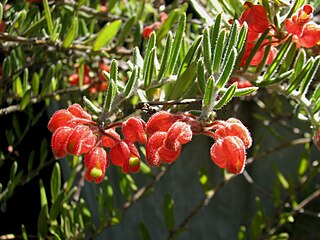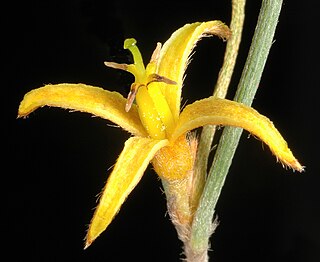
The Australian weasel shark is an uncommon species of ground shark in the family Hemigaleidae. It inhabits shallow waters off northern Australia to a depth of 170 m (560 ft); smaller sharks frequent sand and seagrass habitat and shift to coral reefs as they grow older. A slim, drab species reaching a length of 1.1 m (3.6 ft), it has sickle-shaped fins with dark tips on the second dorsal fin and caudal fin upper lobe. Its upper teeth are broad with strong serrations only on the trailing edge. The lateral line along each side is prominent and exhibits a downward curve below the second dorsal fin.

Banksia polycephala, commonly known as many-headed dryandra, is a species of bushy shrub that is endemic to Western Australia. It has linear, pinnatisect leaves with up to twenty-five triangular lobes on each side, small, creamy yellow flowers in heads of up to seventy and egg-shaped follicles.
Banksia tortifolia is a small, spreading, prostrate shrub that is endemic to the southwest of Western Australia. It has short underground stems, pinnatipartite leaves with sharply-pointed, linear lobes on each side, greenish-cream, yellow and pink flowers in heads of about eighty, and glabrous, egg-shaped follicles.

Flora Australiensis: a description of the plants of the Australian Territory, more commonly referred to as Flora Australiensis, and also known by its standard abbreviation Fl. Austral., is a seven-volume flora of Australia published between 1863 and 1878 by George Bentham, with the assistance of Ferdinand von Mueller. It was one of the famous Kew series of colonial floras, and the first flora of any large continental area that had ever been finished. In total the flora included descriptions of 8125 species.

Ovalipes australiensis is a species of crab found in southern Australia. Its range extends from Western Australia to Queensland, including Tasmania. It is fished commercially and recreationally, although it is not as important as the blue swimmer or mud crab.
Semecarpus australiensis, the Australian cashew nut, is a species of Australian trees that grow naturally in monsoon forests or rainforests, from sea level to 250 m, often near the sea. It has been found in NT, Cape York, and Queensland wet tropics, Australia, Torres Strait Islands, New Guinea, New Britain, Aru Islands and additional Pacific Islands. It is related to the cashew.
Grevillea acuaria is a shrub which is endemic to the south of Western Australia.
Asperoseius is a genus of mites in the Phytoseiidae family.
Asperoseius baguioensis is a species of mite in the family Phytoseiidae.
Asperoseius henryae is a species of mite in the family Phytoseiidae.
Asperoseius lagunensis is a species of mite in the family Phytoseiidae.

Adenanthos sect. Eurylaema is a taxonomic section of the flowering plant genus Adenanthos (Proteaceae). It comprises four species, all of which are endemic to southwest Western Australia.
George Bentham's taxonomic arrangement of Adenanthos was the first comprehensive taxonomic arrangement of that plant genus. It was published in 1870 in his landmark flora of Australia, Flora Australiensis. It would stand for over a hundred years before being superseded by the 1978 arrangement of Ernest Charles Nelson.

Adenanthos sect. Adenanthos is a taxonomic section of the flowering plant genus Adenanthos (Proteaceae). It comprises 29 species. The centre of diversity is southwest Western Australia, with two species extending into South Australia and western Victoria.

Persoonia confertiflora, commonly known as cluster-flower geebung, is a species of flowering plant in the family Proteaceae and is endemic to south-eastern Australia. It is an erect to low-lying shrub with hairy young branches, egg-shaped to narrow elliptic leaves, and hairy yellow flowers borne on leaf axils or on the ends of short branches.

Grevillea saccata, commonly known as pouched grevillea, is a shrub which is endemic to the south-west region of Western Australia. It grows to between 0.25 and 0.5 metres in height. The red flowers usually appear from June to November in the species' native range. The species was formally described in 1870 by English botanist George Bentham in his Flora Australiensis.

Persoonia brevifolia is a plant in the family Proteaceae and is endemic to a restricted area near the border between south-eastern New South Wales and Victoria. It is an erect shrub with elliptic to egg-shaped leaves and cylindrical yellow flowers arranged singly in leaf axils.

Persoonia angustiflora is a species of flowering plant in the family Proteaceae and is endemic to the south-west of Western Australia. It is an erect shrub with hairy branches and leaves, linear, more or less cylindrical leaves and yellow or greenish yellow flowers arranged singly or in groups of up to four.

Isopogon drummondii is a small shrub of the family Proteaceae and is endemic to the southwest of Western Australia. It was first formally described in 1843 by Henri Antoine Jacques in Annales de Flore et de Pomone from an unpublished description by Hügel.

Petrophile semifurcata is a species of flowering plant in the family Proteaceae and is endemic to an area near the west coast of Western Australia. It is an erect, bushy shrub with sharply-pointed, needle-shaped, sometimes lobed leaves and oval heads of silky-hairy, whitish, lemon-yellow or cream-coloured flowers.











